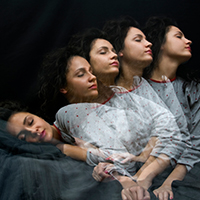Parasomnias are a category of sleep disorders involving unwanted or abnormal movements or behaviors during sleep. These episodes can occur at any point during sleep, including sleep onset, REM sleep (when dreaming) or when awakening.
Parasomnias affect approximately 10% of Americans of all ages, but are more common in children. Often, parasomnias run in families.
The trigger for a parasomnia may be lack of sleep or fragmented sleep, as a result of another sleep disorder, such as obstructive sleep apnea. Stress or medications may also play a part.
Many people who suffer from parasomnias may experience an improvement in their symptoms simply by improving their sleep habits. Keeping a regular sleep schedule, managing stress, following a relaxing bedtime routine, and getting enough sleep can help. Certain medications can be used to control symptoms.
A person should seek treatment whenever there is a risk for injury to oneself or another person. It is important to seek treatment if the parasomnia disrupts a person’s own sleep or the sleep of others in the household, or if there is distress about the symptoms, or if the frequency is high or escalating.
Non-REM (NREM) Sleep Parasomnias
These parasomnias occur during non-REM sleep, usually during the earlier part of the night.
Sleepwalking
Sleepwalking is a condition in which a sleeping individual exhibits behaviors associated with being awake, appears to be awake but is actually still sleeping. The condition is most commonly seen in children aged six to twelve; however sleep walking can occur among younger children, adults, and the elderly.
Sleepwalking episodes may involve simple activities such as sitting up in bed or walking to the bathroom or the more extreme, including walking outside or getting into a car and driving. The sleepwalker often has little or no memory of the event.
Sleepwalking can be dangerous, as the sleepwalker is unaware of surroundings and can bump into objects or fall.
Contrary to common belief, it is generally safe to wake a sleepwalker, although it may be easier just to lead them back to bed. In many cases, sleepwalkers do not need extensive examinations or testing. For those individuals where episodes are persistent or involve unusual behaviors, our sleep specialists will perform tests to rule out certain triggers. In some cases, sleepwalking may be treated with medications.
Sleep-Related Eating Disorder (SRED)
Sleep-Related Eating Disorder (SRED) is a potentially dangerous variant or extension of sleepwalking, in which the individual sleepwalks to the kitchen and eats and drinks at random. Typically, the sufferer eats high-carbohydrate and high-fat foods during the episode, but may also eat bizarre items such as coffee grounds, raw foods, frozen foods or toxic items. SRED is not driven by hunger or thirst, but is an involuntary activity unrelated to normal eating needs and preferences. In severe cases, SRED can lead to obesity, diabetes, hypertension or other diet-related problems.
Accidents may occur from using knives and appliances, or ingesting poisonous products.
SRED is more common in women and typically starts in the 20’s.
Medications may be helpful in controlling the symptoms.
Sleep Terrors
Sleep Terrors, also called “night terrors” are characterized by intense, violent and inconsolable feelings of terror or dread, along with a temporary inability to attain full consciousness. The events are often accompanied by screaming, gasping or thrashing around. However, the person is not fully awake, and once the episode passes, he or she often returns to normal sleep without fully waking up. There usually is no recollection of the episode in the morning.
Sleep terrors are more common in children, but can occur at any age.
Emotional stress during the day, fatigue or an irregular bedtime may trigger episodes. Medication may be used in controlling the occurrences, but good sleep hygiene practices will help reduce sleep terrors.
Confusional Arousals
A confusional arousal occurs when a sleeping person appears to wake up but their behavior is unusual or strange. The individual may be disoriented, unresponsive, have slow speech or confused thinking. Confusional arousals usually occur in the first 2 hours of falling asleep, during a transition from deep sleep to a lighter stage of sleep. There is little or no recall of the event the next morning.
Confusional arousals can occur at any age, but are more common in children. Triggers for an episode may include travel, abrupt sleep loss, migraines and irregular sleep-wake schedules.
REM Parasomnias
REM Behavior Disorder (RBD)
Dreaming occurs during REM (rapid eye movement) sleep. While an individual is in REM sleep, there is reduced muscle tone in many of the body’s muscles (muscle atonia). Muscle atonia is a protective mechanism that causes immobilization and prevents people from enacting their dreams. In RBD, this immobilization is partially or completely absent, allowing the sleeper to move and act out their dreams. Movements can result in behavior that may cause injury to the individual or the bed partner. To make things worse, the dreams are usually more vivid and intense than usual, often involving classic fight-or-flight scenarios.
Behaviors may include twitching, utterances, flailing, kicking, sitting up and leaving the bed. At the end of the episode, the individual may awaken and become quickly alert. RBD is more common in older males.
The diagnosis of RBD should be confirmed by a sleep study, to evaluate for other sleep disorders and to confirm abnormal muscle tone during REM sleep. RBD usually can be controlled with the use of appropriate medications.
